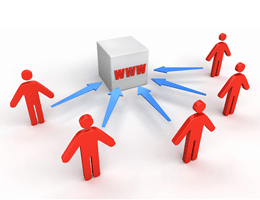WEB 2.0
Web 2.0 is a concept that was coined in 2003 and refers to the social phenomenon that arose from the development of various applications on the Internet . The term establishes a distinction between the first era of the Web (where the user was basically a taxpayer who received the information or published it, without there being too many possibilities for the interaction to be generated) and the revolution that the rise of the blogs, social networks and other related tools.
Web 2.0, therefore, is made up of platforms for publishing content, such as Blogger , social networks, such as Facebook , services known as wikis ( Wikipedia ) and photo, audio or video hosting portals ( Flickr , YouTube ). The essence of these tools is the possibility of interacting with the rest of the users or contributing content that enriches the browsing experience.
It is important to bear in mind that there is no precise definition of Web 2.0, although it is possible to approximate it by setting certain parameters . A web page that is limited to displaying information and is not even updated is part of generation 1.0. On the other hand, when the pages offer a considerable level of interaction and are updated with the contributions of the users, we speak of Web 2.0.
It is worth mentioning that the differences between the first and second era of the Web are not based on a technological change in servers, although naturally there has been a considerable advance in hardware; it is the approach of the Web, the objectives and the way in which users began to perceive information online that characterizes this rebirth, which took place silently but quickly, at the beginning of the new millennium.
Until then, the Internet was a universe of mostly static data, a revolutionary source of reference that attracted millions of people to contemplate it passively . Although forums and chat date from Web 1.0, they were well differentiated from traditional sites (as is the case today); Navigating was similar to visiting a large shopping center, with countless stores, in which it was possible to buy products, but not alter their windows.
 With the arrival of Web 2.0, there was a social phenomenon that forever changed our relationship with information, mainly because it made us part of it : at present, news about a demonstration against animal abuse is not complete without show how many Facebook users read and enjoyed it, what percentage of readers are in favor of the movement, and the comments, which often provide important data or point out errors.
With the arrival of Web 2.0, there was a social phenomenon that forever changed our relationship with information, mainly because it made us part of it : at present, news about a demonstration against animal abuse is not complete without show how many Facebook users read and enjoyed it, what percentage of readers are in favor of the movement, and the comments, which often provide important data or point out errors.
As with any milestone in the history of mankind, the democracy associated with Web 2.0 has had a serious impact on the traditional media, especially those who did not know how to adapt to this new wave of freedom. The last decade has seen the birth of various independent newspapers and magazines that have managed to establish themselves and achieve great success worldwide, as opposed to the decline of ancient colossi.
It is not easy for journalists to accept that under an article that took them days of investigation and preparation, users have the right to insult and despise them, to threaten their families or to hang photomontages with their faces; But these are some of the negative consequences of Web 2.0, and only by accepting them and cunningly avoiding abuses is it possible to achieve success without dying trying .
Some experts associate Web 3.0 with the Semantic Web , which consists of the inclusion of semantic or ontological metadata (which describes the contents and the relationships between the data) so that they can be tracked by processing systems.
Comments
Post a Comment